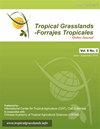Biomass production and nutritional properties of promising genotypes of Tithonia diversifolia (Hemsl.) A. Gray under different environments
IF 0.7
4区 农林科学
Q3 AGRICULTURE, DAIRY & ANIMAL SCIENCE
引用次数: 0
Abstract
Tithonia diversifolia is a shrub with excellent forage characteristics that has shown a wide genetic and phenotypic diversity. The objective of this study was to determine the biomass production and nutritional quality of seven genotypes of T. diversifolia with outstanding characteristics for ruminant nutrition, to analyze the Genotype x Environment (GxE) interaction of biomass production and to compare the performance of these genotypes with grasses offered normally in tropical conditions. For the GxE interaction the AMMI and SREG models were used, and evaluations were made in three environments. In the GxE analysis, the interaction was significant and effects of the environment on biomass productivity were observed with differences between genotypes (p <0.05). In the three environments, the chemical composition was adequate to be offered to ruminants. It is worth noting the high content of crude protein (28.89 g/100 g of dry matter - DM), the low fiber content (30.95 g of neutral detergent fiber - NDF/100 g of DM) and the high percentages of in vitrodegradation of DM for all the genotypes. It is possible to conclude that there are superior genotypes of T. diversifolia with the ability to have good productive and adaptive performance for high-altitude and low-altitude zones with low fertility soils.不同环境下多样叶山雀优良基因型的生物量生产及营养特性
黄叶铁藤是一种具有优良牧草特性的灌木,具有广泛的遗传和表型多样性。本研究的目的是确定7个具有反刍动物营养特征的基因型的生物量产量和营养品质,分析基因型与环境(GxE)的相互作用,并将这些基因型的生物量产量与热带条件下通常提供的牧草的性能进行比较。对于GxE相互作用,使用AMMI和SREG模型,并在三种环境下进行了评估。在GxE分析中,交互作用显著,环境对生物量生产力的影响在基因型之间存在差异(p <0.05)。在这三种环境中,化学成分足以提供给反刍动物。值得注意的是,所有基因型的粗蛋白质含量高(28.89 g/100 g干物质- DM),纤维含量低(30.95 g中性洗涤纤维- NDF/100 g DM), DM体外降解率高。结果表明,在低肥力土壤的高海拔和低海拔地区,存在着具有较好生产和适应能力的优势基因型。
本文章由计算机程序翻译,如有差异,请以英文原文为准。
求助全文
约1分钟内获得全文
求助全文
来源期刊

Tropical Grasslands-Forrajes Tropicales
Agricultural and Biological Sciences-Agronomy and Crop Science
CiteScore
1.60
自引率
0.00%
发文量
36
审稿时长
16 weeks
期刊介绍:
The Journal publishes, in English or Spanish, Research Papers and Short Communications on research and development, as well as contributions from practitioners (Farmer Contributions) and Review Articles, related to pastures and forages in the tropics and subtropics. There is no regional focus; the information published should be of interest to a wide readership, encomprising researchers, academics, students, technicians, development workers and farmers.
In general, the focus of the Journal is more on sown (''improved'') pastures and forages than on rangeland-specific aspects of natural grasslands, but exceptions are possible (e.g. when a submission is relevant for a particularly broad readership in the pasture and forage science community).
The Journal will also consider the occasional publication of associated, but closely related, research in the form of an additional scientific communication platform [e.g. a re-make of the former Genetic Resources Communication series of the former Division of Tropical Crops and Pastures of the Commonwealth Scientific and Industrial Research Organisation (CSIRO), Australia].
Areas of particular interest to the Journal are:
Forage Genetic Resources and Livestock Production[...]
Environmental Functions of Forages[...]
Socio-economic Aspects[...]
Topics within the aforementioned areas may include: Diversity evaluation; Agronomy; Establishment (including fertilization); Management and utilization; Animal production; Nutritive value; Biotic stresses (pests and diseases, weeds); Abiotic stresses (soil fertility, water, temperature); Genetics and breeding; Biogeography and germplasm collections; Seed production; Ecology; Physiology; Rhizobiology (including BNF, BNI, mycorrhizae); Forage conservation; Economics; Multilocational experimentation; Modelling.
 求助内容:
求助内容: 应助结果提醒方式:
应助结果提醒方式:


